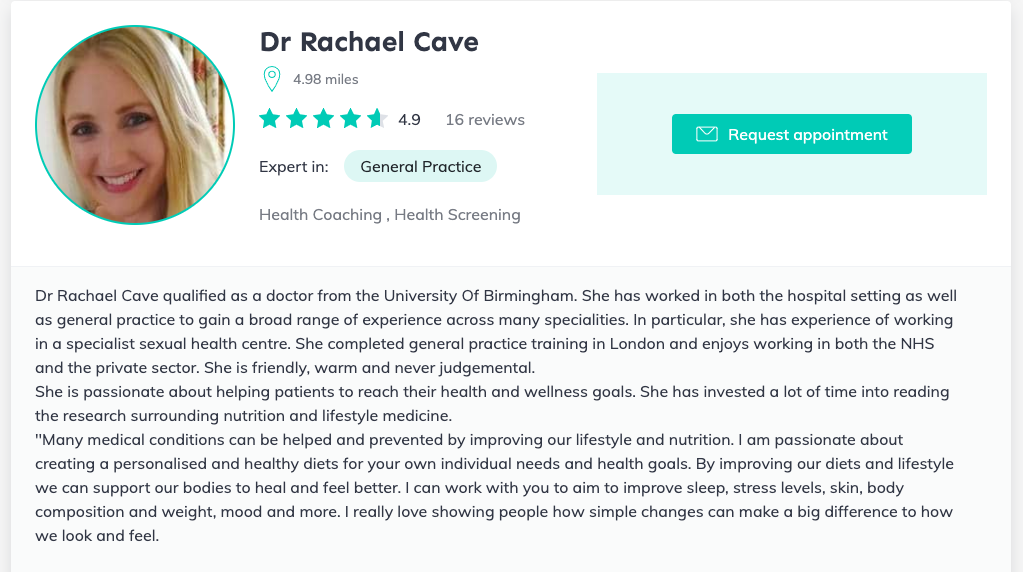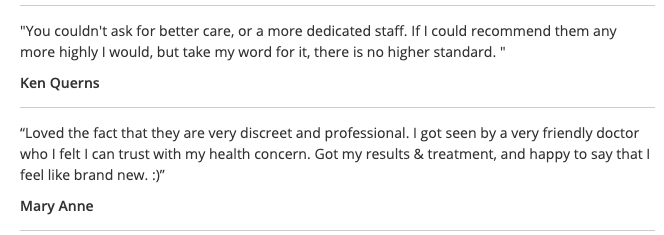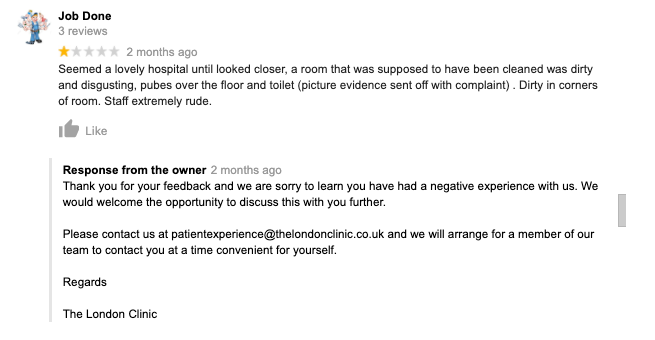Let’s take a look at working with review sites, social media and patient acquisition tools that are rarely used by medical marketing specialists despite being very effective with the right approach.
Learn how to simplify your practice workflow and free up more time for patients with Medesk.
Open the detailed description >>Crowd Marketing and Registering on Review Sites
When choosing a clinic, patients are influenced by your reputation, the cost of services, location, the professionalism of your doctors, their experience at the reception desk, and last but not least, reviews from other patients. If your clinic is new, it’s vital that you encourage your first patients to leave testimonials on review sites. The most popular review portals include:


You can and really should also “plant” reviews yourself by asking patients for permission to post their comments on your profile. Remember that the chosen comments should be written in a mildly complimentary style that gives just enough detail to convince the reader. As long as this is all done in association with your clinic’s profile on a given site, then you have the opportunity to respond to feedback on behalf of your business. You can thank people for their kind words and react to negative comments in a timely manner. On that note, don’t get upset if you see reviews that are less than glowing. Such comments represent an opportunity to change things for the better. At the very least, you should ensure that no review is left without a proper response from your clinic. If criticism is justified in fact, then you need to take it upon yourself to fix your shortcomings and then publicise the measures your clinic took.

Businesses often get a good return on investment from recommendations made on question and answer sites. By providing a detailed response to a user’s query, you help them (and other users) to solve their problems while telling them about your clinic. The difficulty lies in the fact that you need to give a comprehensive response with links to sources and not just give out recommendations. That is to say, you must include links that direct people towards useful resources like Wikipedia rather than just to your website. It may also be to your advantage to mention in passing an inferior competitor (whether in service quality or cost).This promotional channel is known as crowd marketing and its effects can be huge. It works as follows:
- Register yourself on forums, recommendation portals, and question and answer sites.
- Leave a few answers on different topics unrelated to your niche. This is necessary to “warm up” your profile and make it appear more genuine.
- Search for topics and questions that discuss the doctors, clinics and medical services in your locality.
- Give detailed responses and include a link to your website. Answers should be written with as much empathy as possible.
- Repeat.
It can be worth having a few different profiles on the most popular platforms. Veterans of guerilla marketing often set up debates between their own accounts so as to make their answers look more convincing.
Medesk helps automate scheduling and record-keeping, allowing you to recreate an individual approach to each patient, providing them with maximum attention.
Learn more >>Email Marketing
“Urgh, more spam! Why are you even sending me this?!” A common response to newsletters but one that should be unfounded if you do things right. Email marketing is effective only when recipients have voluntarily subscribed to your newsletters. When recipients are site visitors, patients, doctors, business partners and whoever else is interested in what you have to say, it’s not spam at all. Your content should be engaging and possess value for its audience in and of itself. Emails can work as a good channel by which to release information about special offers and events, to re-acquire inactive patients, to remind patients about upcoming appointments and actions required from their side. All of these help you to increase your average revenue per appointment, but to hit each target, you need a specific strategy. To get the best results in general, you need to release content that interests your audience and regularly analyse parameters such as open rate and then adapt your approach accordingly.
Why your clinic needs email marketing:
- To advertise special offers and promotions that help to increase sales of services that you want to make more popular
- To bring back patients who you haven’t seen for some time as well as those who were planning on booking an appointment but haven’t got around to it yet
- To remind patients about checkups and increase revenue from returning patients
- To share interesting articles related to your services and your patients’ problems to increase the loyalty of existing patients and demonstrate your expertise to prospective patients
- To inform recipients about new equipment, clinicians with higher qualifications in additional specialities so that patients are more likely to book an appointment
It’s crucial that you realise that email marketing is not a one-time affair. To make this channel work, you need to release newsletters regularly then analyse the statistics and make changes to your content.
Messaging Platforms
It cannot be said that messengers are used for promoting your clinic, but they do help you to attract an audience. This is one of the most popular communication channels for use between businesses and customers as well as between individuals. By placing a live chat button on your website, you demonstrate the patient-oriented nature of your practice and your willingness to support people. However, if you do decide to add a live chat feature, make sure that your colleagues take responsibility for responding in a timely fashion. Ideally, you ought to reply within 15 minutes and set up a chatbot to handle out-of-hours enquiries. You can then provide ready-made responses to the most popular questions and gather contact details for use on the next workday.
Social Media
People usually only visit the doctor when they really need to. That is, interest in medical services is situational in nature so that once someone has already fallen ill, they aren’t going to put off booking an appointment for months. Prospective patients carefully consider service quality and a doctor’s qualifications when choosing a clinic. That’s why posts along the lines of “20% off MRIs until November 5th” don’t work whereas targeted ads do. The typical methods employed on social media by hairdressers and clothes stores simply don’t work in healthcare. In part, this is due to the strict regulations associated with the advertisement of medical services online.
Social media platforms are useful for clinics to gain trust, improve reputation and raise brand awareness among patients, both new and existing. That’s not to mention that it’s much quicker to communicate with your audience on social media. Prospective patients can ask questions and receive a response much faster than if they were to use email. You should create groups according to interests on social media and internet forums so you can publish useful information for people to educate themselves, whether by getting an answer to their questions or advice on how to solve their health issues.

Information about your clinic should be appropriate and not obtrusive. Tell people about your clinicians, answer questions, publish medical news, and ask your doctors to work on their personal profiles. After all, many patients choose by the doctor, not by the clinic.Facebook and Instagram are two of the main social media platforms through which you can promote your clinic. You can also look into using Twitter and LinkedIn, although they may be less effective.
Targeted Ads
Targeted advertising works via social media. It is a promotional tool that allows you to show specific ad campaigns to certain people based on their gender, age, location, socioeconomic status, marital status, and interests.
Discover more about the essential features of Medesk and claim your free access today!
Explore now >>Unlike context ads which tend to work in the case of high demand, targeted ads capture those who might be interested in your services based on hypotheses proposed by marketing specialists.
The main difficulty in setting up targeted ads lies in defining which audience to search for in the first place. No clinic is exactly like any other, and it’s clear the target audience belonging to a plastic surgeon is going to be different from that of a GP. Nevertheless, there are some general trends that can be relied upon, such as the observation that the people most likely to click an medically-themed advertisement are women over 30. In contrast, men of all ages tend to put off treatment until the last minute and so are much less likely to click a medical ad.
Target, amongst others:
- Those belonging to particular social media groups and competitors’ pages;
- Those with a clear interest in health;
- Geographic regions.
Social Media Optimization (SMO)
Social Media Optimization usually implies the optimization of a website for social media purposes. For example, it could include the addition of social media buttons, links, comments and so on. However, we are going to dig into this topic in more depth. SMO helps you to unite the offline and online worlds to bring people over from the physical to the digital space, where it’s easier for you to stay connected. For a given group of people, you can set up ads, send newsletters, run a blog, and receive reviews that will be read by other such people.
Do the following to unite these two worlds:
- Place QR codes and shortened links to your social media pages in and around your clinic where they would be easily noticed. Come up with a call to action so people understand why they should visit your pages or subscribe to your content.
- Display your clinic’s online ratings at the reception desk and entrance to boost trust in existing patients and interest in those passing by outside.
- Think up unique hashtags for your promotional campaigns and offers and let patients know so they can take advantage.
- Ask patients to leave reviews on popular websites and to include links to your website or other material. You can incentivize them if appropriate to do so by offering lower prices.
The most crucial aspects of your SMO are having a good call to action, appropriate placement of information on social media and review sites, and using shortened links.
QR Code Marketing – An Innovative Approach for Clinics
QR Code marketing is a powerful tool for clinics to engage patients and make essential information accessible with a simple scan. By placing QR Codes in high-traffic areas like waiting rooms, brochures, and social media posts, clinics can guide patients to booking portals, patient feedback forms, wellness resources, and promotional offers. This digital approach not only reduces paper use but also enhances the patient experience by delivering information instantly.
Using QR Code tools that support customization and tracking, clinics can create tailored campaigns that direct patients to educational content, forms, or scheduling systems. Some solutions, like Uniqode, even allow for analytics, helping clinics understand which resources resonate most with patients. This feedback can then guide future campaigns, fostering stronger patient engagement and making it easier for clinics to provide relevant information at the right time.
Put Your Patients First
None of the tools outlined above is going to be effective if there’s no one to answer emails and calls, receptionists are impolite, your premises are unhygienic, or your clinicians are always trying to push unnecessary extra treatments on their patients.
A patient-focused approach in itself works as an effective acquisition channel because word of mouth remains a vital driver of your clinic’s popularity.
The courteousness of your receptionists, professionalism and tact of your clinicians, and your rapid response to patient feedback will all do more to attract additional patients to your clinic than any amount of SEO.
You ought to listen to call recordings and track the number of missed calls. Clinics often lose out on opportunities to attract new patients and retain existing ones due to issues with receptionists and call handling software.
To understand in real-time which promotional tools work and which don’t, it’s crucial that you have access to relevant data on the effectiveness of each of the points above. All clinics should employ a flexible practice management system that can integrate with call tracking, end-to-end analytics solutions like Google Analytics. It’s the only way to know for sure what attracted your patients to your clinic, whether it was a context ad, social media post, or a recommendation from a referral partner.
Checklist - The Main Patient Acquisition Tools Your Clinic Needs
- Familiarize yourself with the main rules and regulations surrounding medical advertising
- Develop a promotional strategy for your clinic based on existing goals
- Carry out an audit of your website to see how user-friendly and attractive it is for patients
- Set up promotional tools on search engines
- Speak with your colleagues and ask them to write a blog article on your clinic website on a weekly basis
- Configure context ads on Google Ads
- Register yourself on review portals, write and respond to comments, react to negative feedback
- Set up newsletters to send out to certain groups of potential and existing patients. Inform them of special offers, discounts etc.
- Create groups on social media sites where you can place interesting content, generate discussion and attach your online booking link
- Configure targeted ads to match the subgroup of the population you want to attract
- Continuously improve your service quality as word of mouth remains one of the most effective channels of patient acquisition
Source: Noobpreneur


